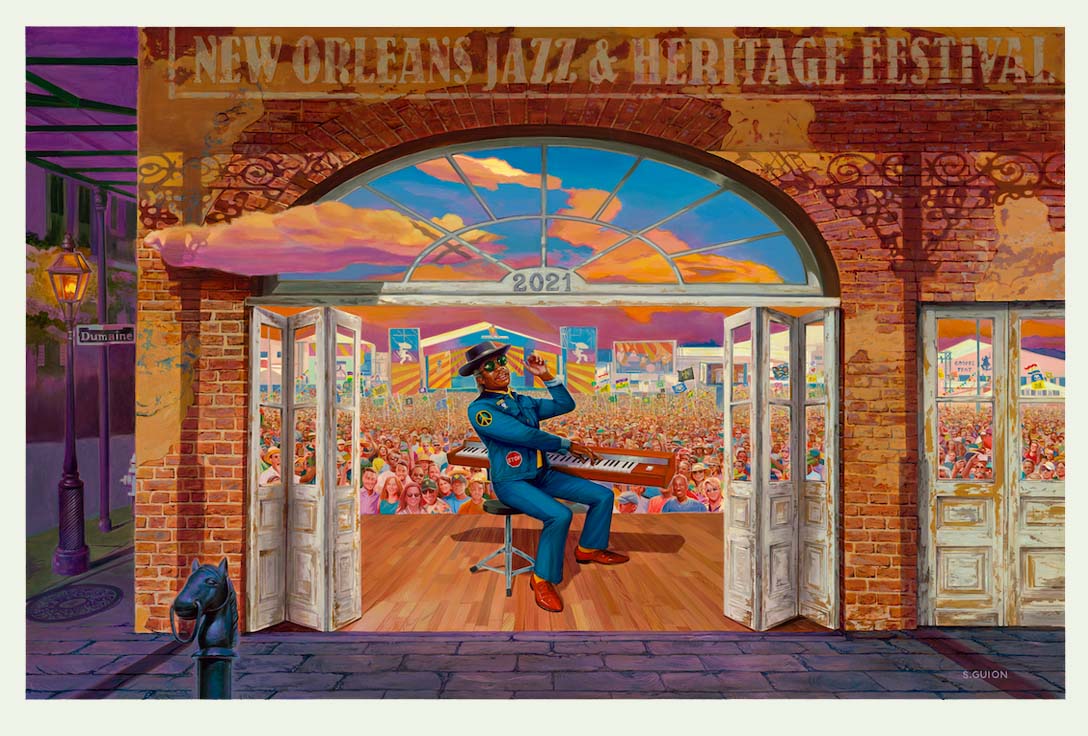Jazz Fest may be the most anticipated—and frustrating—waiting game in New Orleans. Around two months prior to the event, expectant fans begin awaiting news of the headline acts. Others check the official website to see who among the great pantheon of Louisiana legends will grace this year’s poster. However, the road to the latter is even longer than fest-goers may be aware. In recent history, there’s no one who knows that journey better than Scott Guion, the artist behind the fest’s last three posters, including the 50th anniversary edition from 2019.
“As crazy as it is, this is my third year in a row,” says Guion. “It takes almost all year from hashing out an idea with the publisher and input from Jazz Fest Foundation. Then, that’s when my real work begins because I have to interpret that idea, which could be fairly abstract and loose and make it into something real. Hardly ever [do I] hit that out of the park on the first swing.”
Only after “weeks and weeks and weeks and weeks of sketching,” does Guion approach the publisher with something that might vaguely resemble what we’ll see for sale at the Fest’s merchandise test and framed on walls across the city. Even the mind-melting meticulousness of the 50th poster, with its arssemblage of Louisiana music icons evoking the cover of the Beatles’ Sgt. Pepper’s Lonely Hearts Club Band album, was the culmination of a small forest’s worth of sketches.

The official silk-screen poster for the 2021 New Orleans Jazz & Heritage Festival by Scott Guion features piano player Henry Roeland Byrd, best known as Professor Longhair, ©2021 Art4now, Inc. Art4now.com. TM NOJ&HF Foundation, Inc. All rights reserved.
Like all commercial art gigs, the poster is a commissioned piece, a request from the Jazz Fest powers that be to bring to life the artist of their choosing. The choice is one made long before Guion is ever called up. Otherwise, he says that he’d probably end up painting “somebody no one ever heard of.” He feels each of the city’s musicians plays an equally large and significant part in its musical ecosystem. Still, Guion expresses that portraying the assemblage of artists for the 50th was a privilege for which he’s still pinching himself. The 2021 poster, for a Jazz Fest that was cancelled in the spring, postponed until October, and then canceled again, features a likeness of Henry Roeland Byrd (1918–1980), the masterful piano player better known as Professor Longhair. Byrd enjoyed widespread acclaim in the latter years of his life thanks in part to exposure at the New Orleans Jazz and Heritage Festival.
“It’s special for me because he (Professor Longhair) represents something that is really a good microcosm of New Orleans because he invented a style of music that’s uniquely him,” says Guion. “And he (Quint Davis, the producer of Jazz Fest) got him on a stage in front of a bunch of people, and they loved it. And he came alive. At the end of his life people appreciated him, and he was putting the joy out there. He became the Professor Longhair that we knew and loved, even though he was that the whole time. That’s New Orleans. I know a lot of geniuses like that.”
Scott Guion takes a personally impersonal approach to painting. He removes himself almost entirely from the process, leaving only his style and execution. His technique is in some ways just as lofty and offbeat as the festival itself. After all, it’s no small feat to distill an artist’s mythos into a single image. In terms of method, Guion is likely one of few major artists to count house paint amongst his preferred tools because it creates “a cool effect of layering” and vibrant colors. However, the art of the Jazz Fest poster requires more than purely technical practice and preparation.
“I started putting on Professor Longhair records…listening to all the records all the time. I listened to interviews with him. There’s a fantastic movie called Fess Up which is a long interview with him. I read about him. I want to just absorb, even if I don’t know exactly how it’s coming through.”
Therefore, for Guion, a successful Jazz Fest poster is one that similarly immerses the viewer not only in the scene but also in the city. He cites James Michalopoulos’ 2001 Louis Armstrong tribute as his ideal fest poster with its faithful portrayal of “the depth and richness of a New Orleans French Quarter night.” For the New Orleans native and now Nashville transplant, there are few things more important than properly depicting his city and muse.
“In New Orleans…all of those people, all of those events. It’s all recorded in the air, and you feel it. The second you get off the Interstate and start driving through the streets,” Guion waxes. “Everybody says it’s like no place else in the world, and that’s why I keep returning to it in my art. They say painters paint the same paintings over and over and over again. That’s true in my case.”
When asked about his preferred poster or painting, Guion responds that “my favorite one is always the one that I’m doing next.”
Limited numbers of the 2021 New Orleans Jazz and Heritage Festival posters are available for sale at Art4Now.com.




